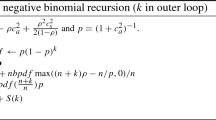Abstract
Simple expressions are given for the mean delay, mean waiting time, and mean busy period length in a multiplexer. Data streams with active periods having a general distribution are permitted, and the data rate during the active periods can be random. Data can also arrive in batches. The key restrictions of the model are that the sources are independent, idle periods are exponentially distributed, and a source generates at least enough data during an active period to keep the server busy throughout the period. The exact formulas allow evaluation of the error in approximations such as a heavy traffic diffusion approximation.
Both continuous and discrete time models are considered. The discrete-time model includes that studied by Viterbi and subsequently generalized by Neuts. The Pollaczek-Khinchine formula for the mean amount of work in anM/GI/1 queue is retrieved as a limiting case.
Similar content being viewed by others
References
S. Asmussen,Applied Probability and Queues (Wiley, New York, 1987).
K.W. Fendick, V.R. Saksena and W. Whitt, Dependence in packet queues, IEEE Trans. Commun. COM-37 (1989) 1173–1183.
K.W. Fendick, V.R. Saksena and W. Whitt, Investigating dependence in packet queues with the index of dispersion of work, IEEE Trans. Commun. COM-39 (1991) 1231–1244.
L. Georgiades, Relations between arrival and time averages of a process in discrete-time systems with conditional lack of anticipation, Technical Report UVA/5525ul5/EE87/102, University of Virginia (1987).
L. Green, A limit theorem on subintervals of interrenewal times, Oper. Res. 30 (1982) 210–216.
H. Kaspi and M. Rubinovitch, The stochastic behavior of a buffer with non-identical input lines, Stoch. Proc. Appl. 3 (1975) 73–88.
O. Kella and W. Whitt, A storage model with a two-state random environment, Oper. Res. 40 (1992) S257-S262 (Supplemental issue).
L. Kleinrock,Queueing Systems, vol. 1 (Wiley, New York, 1975).
S.P. Morgan and C.Y. Lo, Mean message delays for two packet-FIFO queueing disciplines, IEEE Trans. Commun. COM-38 (1990) 744–746.
M. Neuts, On Viterbi's formula for the mean delay in a queue of data packets, Commun. Statis. Stoch. Models 6 (1990) 87–98.
M.I. Reiman, A multiclass feedback queue in heavy traffic, Adv. Appl. Prob. 20 (1988) 179–207.
A.M. Viterbi, Approximate analysis of time synchronous packet networks, IEEE J. Sel. Areas Commun. SAC-4 (1986) 879–890.
Author information
Authors and Affiliations
Additional information
Preliminary version presented at IEEE INFOCOM, San Francisco, April 1993.
Rights and permissions
About this article
Cite this article
Dupuis, H., Hajek, B. A simple formula for mean multiplexing delay for independent regenerative sources. Queueing Syst 16, 195–239 (1994). https://doi.org/10.1007/BF01158956
Received:
Revised:
Issue Date:
DOI: https://doi.org/10.1007/BF01158956



